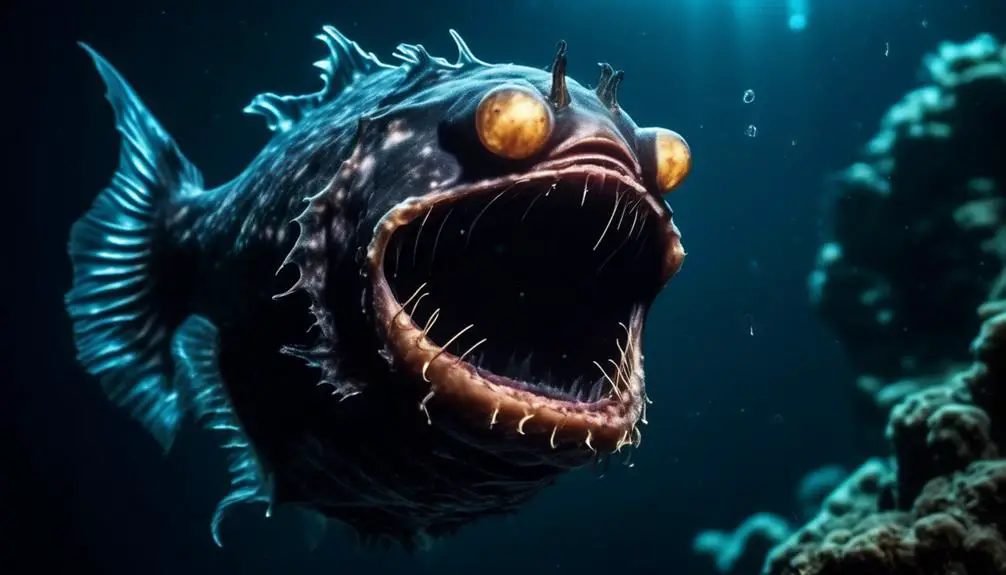Are you prepared to embark on a voyage through the mysterious depths of the world’s oceans, where you’ll come face to face with some of the most unsightly creatures imaginable?
Picture this: a fish with a face so squishy and shapeless that it’s been dubbed the ‘blobfish.’ This unfortunate-looking creature is just the tip of the iceberg when it comes to the world of ugly fish species. But what makes these fish so repulsive, and why do they hold such a morbid fascination for us?
As you delve into the realm of the ugliest fish in the world’s oceans, you’ll discover a whole new perspective on the concept of beauty, and perhaps find a profound appreciation for the extraordinary adaptations that these creatures possess.
So, brace yourself for a journey into the bizarre and grotesque as we explore the depths of the world’s oceans and uncover the secrets of the ugliest fish species that call it home.
Blobfish: The Blob-like Ugly Fish
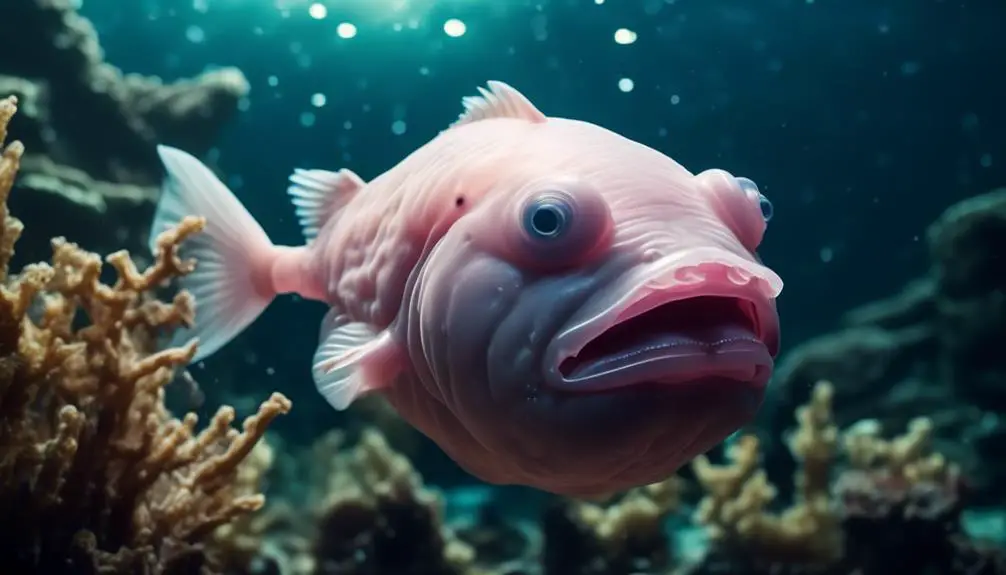
The Blobfish, known for its blob-like appearance, is considered one of the ugliest fish species in the world’s oceans. With its droopy, gelatinous body and sad-looking face, it’s no wonder why this fish has gained such a reputation. Blobfish are typically found in the deep waters off the coasts of Australia, New Zealand, and Tasmania.
One of the main reasons why the Blobfish is considered ugly is its lack of muscle structure. Due to the extreme pressure in their deep-sea habitats, their bodies have adapted to be soft and gelatinous. This allows them to survive in the depths where other fish would be crushed. However, this adaptation gives them a blob-like appearance that’s far from visually appealing.
Another reason for their unattractive appearance is their lack of a swim bladder, which is an organ that allows most fish to control their buoyancy. Without a swim bladder, Blobfish simply float above the ocean floor, looking rather silly and out of place.
Despite their unappealing looks, Blobfish serve an important role in the deep-sea ecosystem. They feed on small crustaceans and other bottom-dwelling organisms, playing a part in the food chain. So, while they may not win any beauty contests, they’re a vital part of the ocean’s biodiversity.
Frilled Shark: The Prehistoric Nightmare
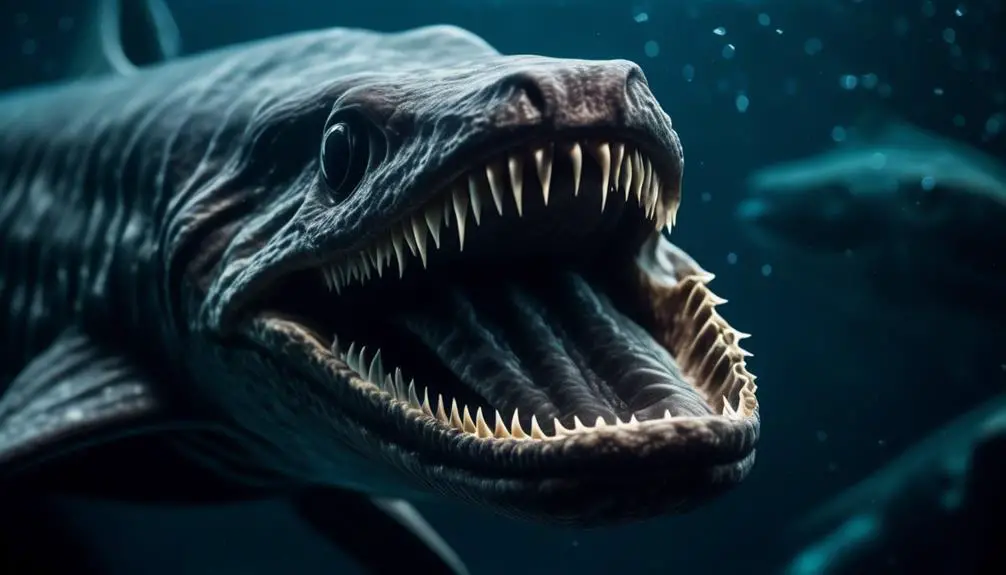
Prepare to be amazed by the eerie and ancient presence of the Frilled Shark. This prehistoric nightmare has a long, slender body that can reach up to six feet in length. Its most distinctive feature is its frilled, or ruffled, gills that give it its name. These gills, which resemble a frilly collar, are a unique adaptation that allows the shark to efficiently extract oxygen from the water.
The Frilled Shark is often referred to as a ‘living fossil’ due to its primitive characteristics and resemblance to ancient shark species. It has a mouth filled with rows of needle-like teeth, perfectly suited for grasping and swallowing its prey whole. This shark primarily feeds on squid and other small fish found in the depths of the ocean.
Found in the deep waters of the Atlantic and Pacific Oceans, the Frilled Shark is rarely encountered by humans. Its elusiveness and mysterious appearance only add to its legendary status. Despite its terrifying appearance, the Frilled Shark isn’t a threat to humans, as it resides in depths that are inaccessible to most divers.
Witnessing the Frilled Shark in its natural habitat is a rare and awe-inspiring experience. Its ancient lineage and unique adaptations make it a true marvel of the underwater world.
Angler Fish: The Terrifying Deep-Sea Predator
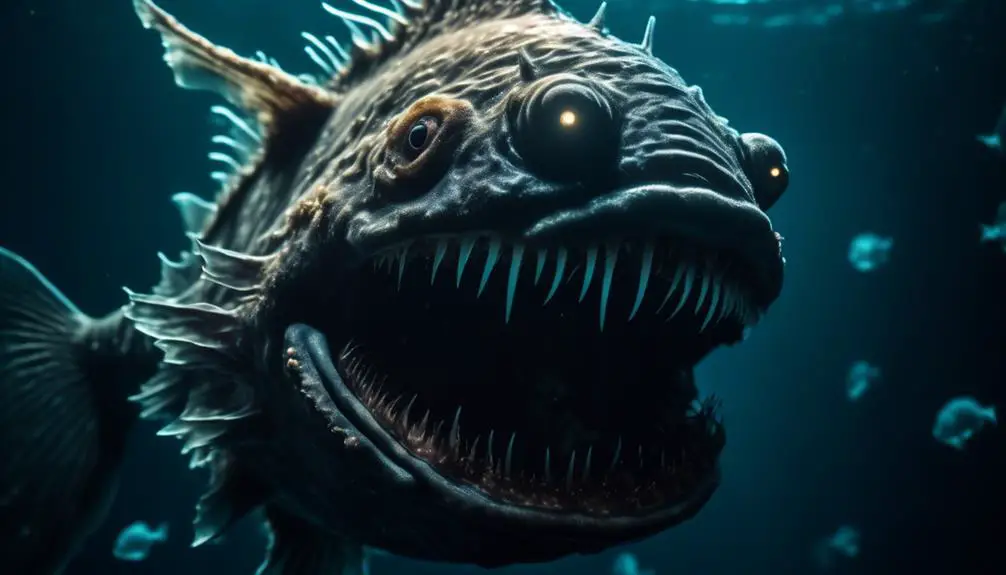
With its grotesque appearance and formidable hunting tactics, the Angler Fish lurks in the depths of the ocean, ready to strike fear into the hearts of any unsuspecting prey.
This deep-sea predator is known for its unique adaptation: a bioluminescent lure that dangles from its head like a fishing rod. The lure emits a mesmerizing light that attracts curious prey, who are then met with a nightmarish surprise. The Angler Fish has an enormous mouth filled with sharp, needle-like teeth, capable of swallowing prey whole.
Its large head and body are covered in rough, warty skin, giving it a truly terrifying appearance. This fish is a master of camouflage, blending seamlessly with its dark surroundings, making it nearly invisible to its prey. The Angler Fish is also equipped with a highly sensitive lateral line system, allowing it to detect even the slightest vibrations in the water, ensuring that no potential meal goes unnoticed.
Its ability to survive in the harsh, dark depths of the ocean and its ruthless hunting tactics make the Angler Fish a true terror of the deep sea.
Red-Lipped Batfish: the Fish With a Facial Disguise
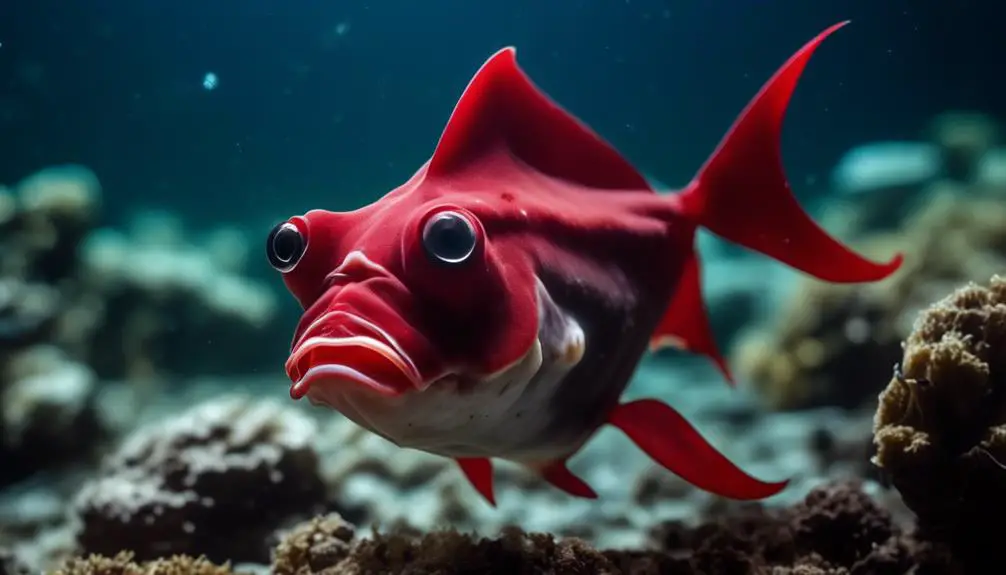
As we plunge deeper into the world of terrifying deep-sea predators, one fish stands out with its unique and cunning disguise – the Red-Lipped Batfish.
This fish, found in the waters of the Galapagos Islands and off the coast of Peru, isn’t your average-looking creature. Its most distinctive feature is its bright red lips, which give it its name.
These lips aren’t just for show, though. They actually serve a purpose. When the Red-Lipped Batfish lies on the ocean floor, its lips resemble small worms, attracting unsuspecting prey closer. Once the prey gets close enough, the batfish strikes with lightning speed, capturing its meal.
But the facial disguise doesn’t end there. The Red-Lipped Batfish also has a flattened face and a wide, pouting mouth, which adds to its overall bizarre appearance. It’s amazing how nature has equipped this fish with such a unique and effective way to catch its food.
Monkfish: The Camouflaged Sea Monster
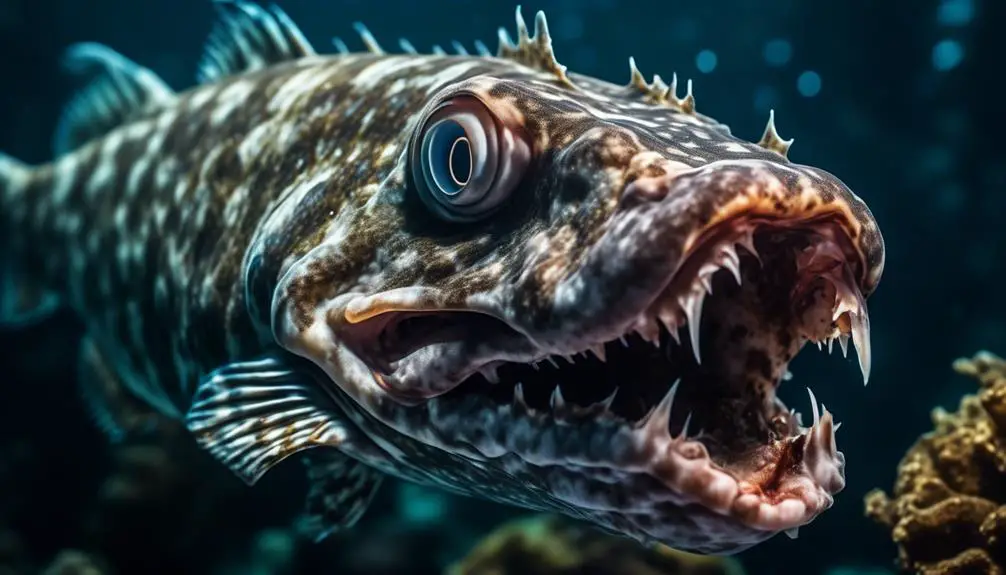
The Monkfish, lurking in the depths of the ocean, is a camouflaged sea monster that will leave you in awe of its deceptive appearance. With its unique adaptations, this fish has mastered the art of blending in with its surroundings. Its body is covered in a mottled pattern of brown, gray, and green, allowing it to seamlessly merge with the rocky ocean floor. Its large, gaping mouth is filled with sharp teeth, ready to ambush unsuspecting prey. This monstrous creature can grow up to three feet long and weigh over 50 pounds, making it a formidable predator.
But don’t let its terrifying appearance fool you. Despite its monstrous looks, the Monkfish is actually a delicacy in many cuisines. Its firm, white flesh is prized for its sweet flavor and versatility in cooking. However, catching these elusive creatures is no easy task. Fishermen must navigate the treacherous depths where the Monkfish resides and use special techniques to lure them out of their hiding places.
Sloanes Viperfish: The Fanged Creature of the Abyss
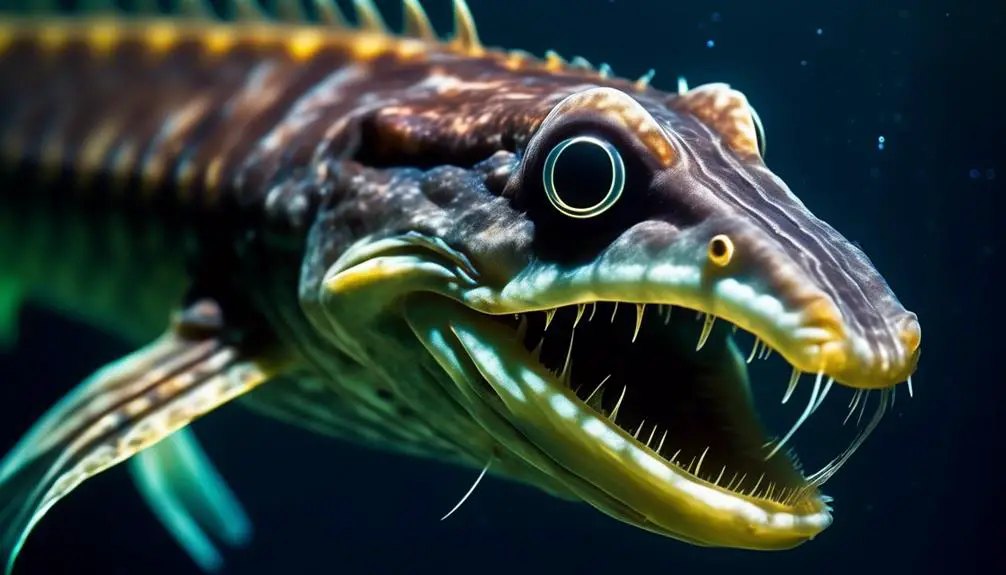
Now let’s explore the mysterious world of the abyss with the Sloanes Viperfish, a fanged creature that will send shivers down your spine.
The Sloanes Viperfish, or Chauliodus sloani, is a deep-sea dweller that can be found in the depths of the ocean. With its menacing appearance, this fish is truly a sight to behold. It has a long, slender body that can reach up to 11 inches in length, and its most distinctive feature is its large, fang-like teeth. These teeth are so long that they actually curve back towards the fish’s eyes when its mouth is closed. This gives the Sloanes Viperfish a truly menacing look.
In addition to its teeth, this fish also has a bioluminescent organ on its belly, which it uses to attract prey. It uses its sharp teeth to capture smaller fish and crustaceans, which it swallows whole. The Sloanes Viperfish is a master of the deep sea, and its unique adaptations allow it to thrive in the extreme conditions of the abyss.
Hagfish: The Slimy and Repulsive Fish
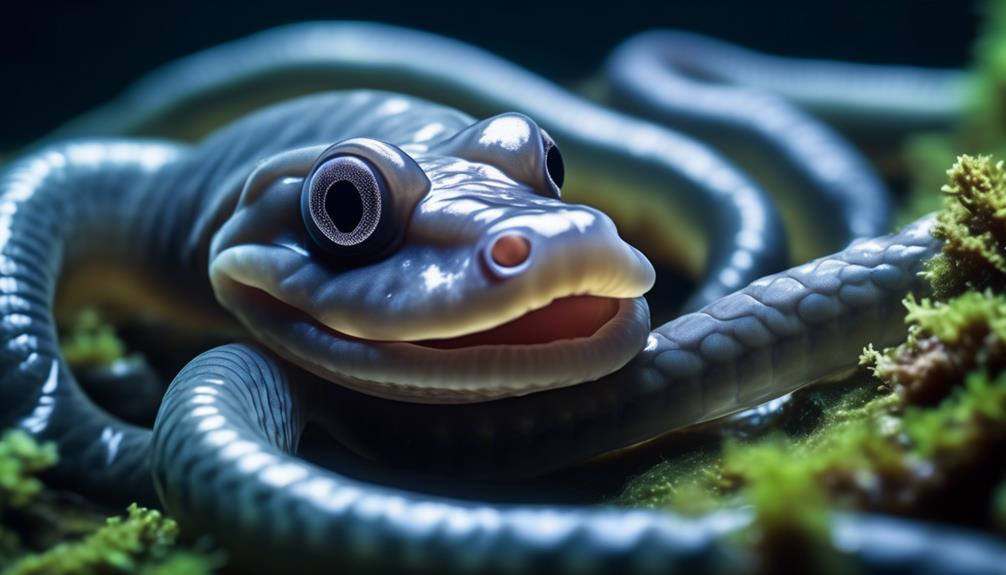
You might find it hard to believe, but the hagfish is one of the slimiest and most repulsive fish in the world’s oceans. This unique creature is known for its slimy and slippery skin, which it secretes as a defense mechanism when threatened. The hagfish has a long, eel-like body that lacks scales and a well-defined head. Its mouth is circular and surrounded by rows of sharp teeth, which it uses to feed on dead or dying animals.
In addition to its slimy appearance, the hagfish also has some bizarre habits. It has the ability to produce copious amounts of slime, which it uses to suffocate its prey or deter predators. This slime is so thick and sticky that it can clog the gills of other fish, causing them to suffocate. The hagfish is also known for its scavenging behavior, often entering the bodies of dead or dying animals and feeding on their flesh from the inside out.
Despite its repulsive appearance and habits, the hagfish plays an important role in the ocean ecosystem by cleaning up dead and decaying matter. Its slimy secretion may be unpleasant to humans, but it serves as a crucial defense mechanism for the hagfish in the harsh underwater world.
Goblin Shark: the Horror From the Deep
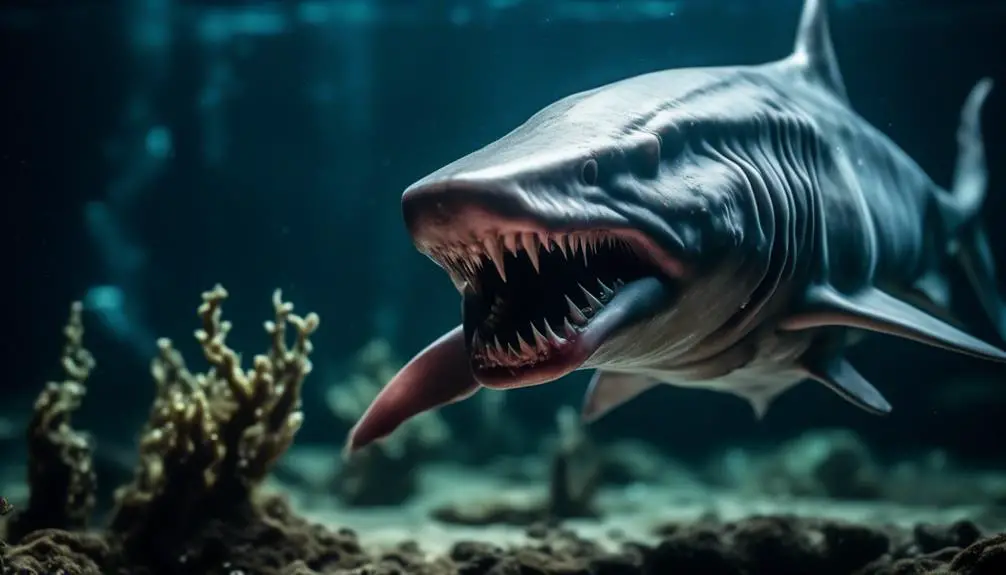
With its nightmarish appearance and deep-sea habitat, the Goblin Shark is a truly terrifying creature from the depths of the ocean. This unique shark is known for its elongated, flattened snout, protruding jaw, and rows of sharp, needle-like teeth. Its skin is a pale pink color, almost translucent, giving it a ghostly appearance.
The Goblin Shark can grow up to 12 feet in length and is often found in waters over 1,000 feet deep, making it a rare sight for humans. Its bizarre and monstrous features have earned it the nickname ‘living fossil’ due to its resemblance to prehistoric creatures.
Despite its horrific appearance, the Goblin Shark isn’t a threat to humans, as it primarily feeds on deep-sea fish and squid. Its ability to protrude its jaw allows it to snatch prey with lightning speed, making it a formidable predator in the dark depths.
Whitemargin Stargazer: The Fish That Stares Into Your Soul
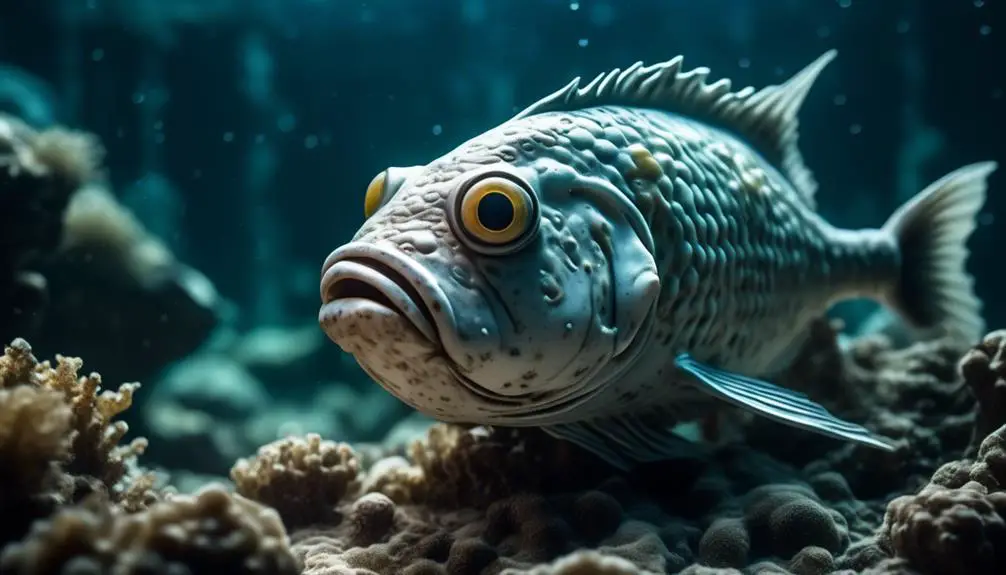
Hiding beneath the sandy ocean floor, the Whitemargin Stargazer emerges as a fish that captivates with its eerie gaze. With its unique and unsettling appearance, this fish has a distinctive feature that sets it apart from the rest. Positioned on the top of its head, the Whitemargin Stargazer’s eyes are directed upwards, giving it a perpetual stare that seems to penetrate your very soul.
Measuring up to 13 inches in length, the Whitemargin Stargazer is a master of camouflage. Its sandy coloration helps it blend seamlessly into its surroundings, making it almost invisible to unsuspecting prey. But it’s the fish’s ability to bury itself in the sand, leaving only its eyes exposed, that truly sets it apart.
Equipped with specialized muscles and bones in its head, the Whitemargin Stargazer can remain motionless for extended periods, waiting patiently for its next meal to swim by. Once the perfect opportunity arises, it launches itself upwards, jaws wide open, devouring its prey in a split second.
While its appearance may be unsettling, the Whitemargin Stargazer’s unique adaptations make it a truly fascinating creature of the deep. So, next time you find yourself diving in the ocean, be sure to keep an eye out for this mesmerizing fish that seems to stare right into your soul.

Erzsebet Frey (Eli Frey) is an ecologist and online entrepreneur with a Master of Science in Ecology from the University of Belgrade. Originally from Serbia, she has lived in Sri Lanka since 2017. Eli has worked internationally in countries like Oman, Brazil, Germany, and Sri Lanka. In 2018, she expanded into SEO and blogging, completing courses from UC Davis and Edinburgh. Eli has founded multiple websites focused on biology, ecology, environmental science, sustainable and simple living, and outdoor activities. She enjoys creating nature and simple living videos on YouTube and participates in speleology, diving, and hiking.
🌿 Explore the Wild Side!
Discover eBooks, guides, templates and stylish wildlife-themed T-shirts, notebooks, scrunchies, bandanas, and tote bags. Perfect for nature lovers and wildlife enthusiasts!
Visit My Shop →
